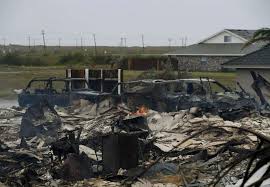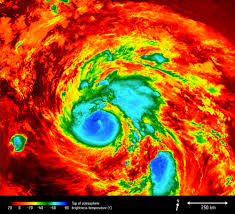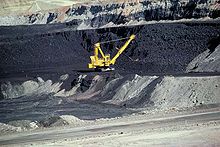How Disaster Response Works
It’s a complex process involving many federal agencies and state government.
When people think of FEMA, they envision rescuers finding victims and taking them to safety. FEMA does provide emergency assistance, temporary housing and other services. But its main job is to coordinate the response of many parts of the federal government. And the federal government's role itself is mostly supportive, with the main job of emergency response falling on state and local governments. President Carter created FEMA in 1978 by combining the functions o...
CONTINUE READINGDid The California Supreme Court “Rip A Huge Hole” In Prop 13 & 218?
New decision could lower voter threshold for local government taxes by voter initiative
UPDATE: This post has been modified from its original version to reflect some ambiguity in the court's decision that I missed on first read. California local governments have long been stymied in efforts to raise taxes for basic infrastructure and services by California's constitution. Two voter-approved constitutional amendments, Prop 13 and Prop 218, require that any new local "special tax" (i.e. for a specific purpose and not for general revenue for the governme...
CONTINUE READINGThe Trump Administration’s Arbitrary Review of National Monuments
Zinke's review has been anything but transparent
Last Thursday, Secretary Zinke submitted a report to President Trump, recommending changes to national monuments. Although Trump’s Executive Order in April called for a "final report" within 120 days--the deadline was Thursday--the Interior Department's press release called the report a "draft." And as Holly Doremus explained on this blog, it has still not been made public. While we don't know exactly what is in Zinke's report, the Washington Post reported that it ...
CONTINUE READINGHouston’s Shockingly Poor Flood Control System
Houston failed to learn a key lesson from Katrina about the need to prepare for catastrophic flooding.
The torrential rain in Houston would have caused bad flooding no matter what. There's no question about that. But it's also true that Houston's flood control efforts have been badly managed. Houston failed to learn a key lesson from Katrina: the most important disaster response is done years in advance through risk mitigation. Not only did Houston fail to plan for anything as bad as Hurricane Harvey; it hasn't taken seriously the lessons of its own repeated floods ...
CONTINUE READINGDisaster Law and Hurricane Harvey
This is the first in what will be a series of posts about disaster law.
As I write, Hurricane Harvey continues to hammer Texas, with rains and flooding expected to last for days. Because the storm is so slow moving, it may dump up to several feet of rain in some locations. For the same reason, it's future trajectory is unclear, so we can't even be sure of what areas will be most affected. It is difficult to think past the immediate plight of the victims. But the reality is that we will be entering a prolonged process that will ultimately ...
CONTINUE READINGWhy isn’t Interior publicly releasing its monuments review?
Secretary Zinke announced that his Department has submitted its review of national monuments to the President, but he's not ready to let you and me see it
Today, the Department of Interior announced that it had sent to the White House its report of the review demanded by an April Executive Order of national monument designations under the Antiquities Act over the last 20 years. In an ordinary world, I would have expected that announcement to be accompanied by a link to the report, but all we got was a 2-page "summary" that attempts to defend the review process, acknowledges that public comments "overwhelmingly" support...
CONTINUE READINGPushing Back Against Presidential Power
It’s time to rethink the amount of power presidents have claimed over regulatory policy.
If there was ever a time to think hard about presidential power, that time is now. That’s a very broad question, but the part most relevant for this blog is the President’s role in controlling government regulation. There is no question that presidents have and will continue to have a huge influence on regulatory policy. The question is whether that influence is in need of checks and balances. In a forthcoming paper, Presidential Administration under Trump, I argue t...
CONTINUE READINGThe ostrich administration
Ostriches actually don't hide their heads in the sand, but the Trump administration sure wants to
It's a myth (of course) that ostriches hide their heads in the sand when they're afraid. Hiding one's head is about the worst possible way to react to danger: it won't make a threat go away, but it will make it awfully difficult to respond effectively. Ostriches are not that stupid. (They apparently do sometimes "flop[] to the ground and remain[] still," which is probably more effective for evading a threat, and can make them look like they have buried their heads.) ...
CONTINUE READINGCoal’s Dismal Future
With or without Trump's policies, those Appalachian coal jobs aren't coming back.
Earlier in August, the governor of West Virginia asked Trump for a billion-dollar bailout of the Eastern coal industry. Under his plan, the federal government would pay power companies $15 per ton to use Appalachian coal. That's a sign of the industry's desperate economic plight. In 2016, global coal use had its biggest drop in history. The U.S. had the largest drop of any country. The decline in U.S. production seems likely to continue, despite a minor blip recently. Th...
CONTINUE READINGPublic Lands Watch: Repeal of Interior valuation rule
Interior Department repeals Obama Administration reforms to the prices paid by energy companies for public oil, gas, and coal resources
The Office of Natural Resources Revenue (ONNR) of the Interior Department published a final rule in the Federal Register earlier this week on August 7th, 2017, that the Department is repealing the “Consolidated Federal Oil & Gas and Federal & Indian Coal Valuation Reform Final Rule.” The 2017 Valuation Rule was published on July 1, 2016 with an original effective date of January 1, 2017. However, it was never gone into effect. Procedurally, the 2017 Valuat...
CONTINUE READING












